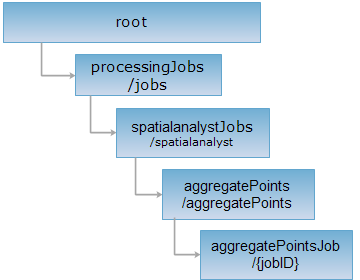URI
<aggregatePoints_uri>/{jobID}[.<format>]
Supported methods
Parent resource
Introduction
aggregatePointsJob resource represents a points aggregation analysis job. By sending a GET request to aggregatePointsJob, you can get a points aggregation job's detailed configuration information, which can be retrieved by {jobID}.
Supported Methods:
- GET: Gets a points aggregation job's detailed configuration information.
- HEAD: Checks whether the aggregatePointsJob resource exists, or if the current user has the authority to access the aggregatePointsJob resource.
Supported output formats:RJSON, JSON, HTML, XML.
Resource hierarchy

HTTP request methods
Execute HTTP request on the following URI, here we take rjosn as the output format as an example. Where, supermapiserver is the server name.
http://supermapiserver:8090/iserver/services/distributedanalyst/rest/v1/jobs/spatialanalyst/topologyvalidator/{jobID}.rjson
GET request
Gets a points aggregation job's detailed configuration information.
Response structure
After executing a GET request on the resource, the response fields are as follows:
| Field | Type | Description |
| id | String | Application ID. |
| state | Jobstate | The status of the task. Including execution status, start time, time consuming, and so on. |
| setting | JobSetting | Lists the detailed info of this aggregatePoints job. Lists the detailed information of the current points aggregation job. |
Response example
Execute a GET request on aggregatePointsJob resource: http://supermapiserver:8090/iserver/services/distributedanalyst/rest/v1/jobs/spatialanalyst/aggregatePoints/127c3fc9_7978_43bc_aded_41d86d92bf42.rjson, then the returned result in rjson format is as follows:
{
"id": "127c3fc9_7978_43bc_aded_41d86d92bf42",
"setting": {
"DEFAULT_MASTER_ADRESS": "local[*] ",
"analyst": {
"fields": "",
"meshType": "0",
"query": "",
"resolution": "1000",
"resultFieldNames": null,
"statisticModes": ""
},
"appName": "summaryMesh",
"args": [
"--input",
"file:/E:/spark/newyork_taxi_2013_01_14k_new.csv",
"--separator",
",",
"--pointIndex",
"10",
"--resolution",
"1000",
"--meshType",
"0",
"--output",
"E:\\supermap_iserver_900_14910_2648_win64_deploy\\supermap_iserver_900_14910_2648_win64_deploy\\webapps\\iserver\\processingResultData\\KernelDensity\\udbs\\6b111b08-7c79-4e14-b414-6d5e5946951e",
"--datasetName",
"analystResult"
],
"contextSetting": null,
"input": {
"datasetInfo": {
"name": "dcsv_newyork_taxi_2013_01_14k_new",
"separator": ",",
"type": "CSV",
"url": "E:\\spark\\newyork_taxi_2013_01_14k_new.csv",
"zindex": 10,
"yIndex": 11
},
"datasetName": "dcsv_newyork_taxi_2013_01_14k_new"
},
"mainClass": "com.supermap.bsp.main.SummaryMeshMain",
"output": {
"cacheName": null,
"cacheType": null,
"datasetName": "analystResult",
"outputPath": "E:\\supermap_iserver_900_14910_2648_win64_deploy\\supermap_iserver_900_14910_2648_win64_deploy\\webapps\\iserver\\processingResultData\\KernelDensity\\udbs\\6b111b08-7c79-4e14-b414-6d5e5946951e"
},
"serviceInfo": null,
"serviceRoot": "http://localhost:8090/iserver/services/",
"type": "SUMMARYMESH"
},
"state": {
"elapsedTime": 0,
"endState": false,
"endTime": 0,
"errorMsg": null,
"errorStackTrace": null,
"publisherelapsedTime": 0,
"runState": "RUNNING",
"startTime": 1494896578700
}
}
HEAD request
Returns the same HTTP response header as the GET request, but no response entity, which can be used to retrieve the meta data contained in response message header without having to transmit the entire response content. Meta data information includes media type, character coding, compression coding, entity content length, etc.
HEAD request is used to determine whether the aggregatePoints resource exists, or if the user has the authority to access it. By executing an HEAD request with a .<format> URI, you can quickly determine whether the aggregatePoints resource supports the <format> representation.